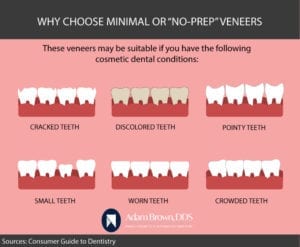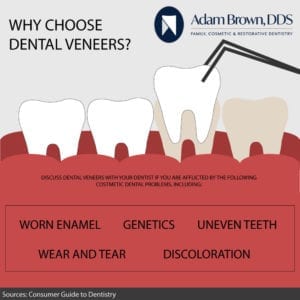
So, you looked in the mirror the other day and thought, “Why can’t I have teeth like Beyoncé?” Or maybe it was more like, “My smile would be complete if I only had a set of chompers like Patrick Dempsey.”
Perfectly-aligned, pearly white teeth can do wonders for your appearance, not to mention all the mental health benefits that come along with them. But orthodontic procedures are not cheap, and they shouldn’t be committed to on a whim.
One type of dental treatment that has increased in popularity over the years is veneers. In short, dental veneers are thin shells that are bonded to your existing teeth to enhance the appearance of those teeth. When everything goes right with the procedure, getting veneers can truly transform your smile (for the better). However, when everything does not go right—and a lot can go wrong—getting veneers can be something you wholeheartedly regret.
Here’s the gist: Getting veneers is a significant investment, and it comes with risks. However, if you determine that it’s right for you, and you go to a qualified cosmetic dentist, it could provide you with a smile you’ve only ever dreamed about.
If you’re considering getting veneers, or even if you’re just looking into it for the first time, then you’ve come to the right place. Not only is there some great information and advice below, but Dr. Adam Brown is the expert cosmetic dentist you want to see!
WHAT ARE VENEERS?
First of all, it will help to understand exactly what dental veneers are. As previously mentioned, veneers are thin coverings that are permanently attached to the front surfaces of your teeth. The most common materials used for veneers are porcelain and composite resin. And ideally, they will match the surrounding teeth in color.
Veneers are being used more and more often by dentists to treat cosmetic issues like stains, chips, and fractures. Typically priced by the individual tooth, you can get a single veneer to fix a defected tooth. However, a lot of people have six to eight veneers put on—usually on the top teeth. While more expensive, this makes it easier to obtain a symmetrical, natural-looking smile.
Most veneers used today are made of porcelain. The procedure for putting on traditional dental veneers is moderately invasive, though not as invasive as implants or crowns. Getting dental implants means replacing the whole tooth, while crowns are caps placed over an existing tooth. Veneers, on the other hand, cover just the front surface of the tooth.

Nonetheless, applying veneers are a conservative approach that requires minimally adjusting the front of the tooth to allow room for the veneer. In many cases, it’s necessary to adjust the tooth past the enamel for the veneers to be placed correctly. The procedure is irreversible and you can expect a local anesthetic to be used.
There is a less invasive option than traditional veneers. “No-prep veneers” don’t require the shaving of a tooth under the enamel, and putting on no-prep veneers is usually a quicker and all-around easier procedure that doesn’t demand an anesthetic. Whether you need traditional or no-prep veneers will depend largely on the condition of your teeth before the procedure.
SCARY STORIES
If you spend as little as two minutes searching the web, you can find a plethora of horror stories of people who have had terrible experiences with their veneers. In most instances, the failing veneers are due to improper application; that is, the dentist did not have the proper experience and skills to do the procedure. However, the materials used for veneers can also cause problems. And when you have an unqualified dentist using cheap materials, it’s a recipe for disaster.
Another thing to consider is that, while the procedure for traditional veneers is irreversible, the veneers themselves are not permanent. Therefore, they often need to be replaced every 10 to 15 years. Here are a few of the most common problems associated with dental veneers failing:
Improper Application
No single person has the same mouth. This may sound obvious, but it is sometimes not taken into consideration during a traditional veneer procedure. All dental veneers must be custom-fit to the individual, and this includes being the right size and shape for the smile’s symmetry. Otherwise, you can run into any number of problems, such as “horse teeth” and vulnerable veneers.
Fractures
Chips and cracks happen most often when veneers are fabricated with cheap porcelain materials. And once you start noticing any signs of breakage, it’s essential to seek help from a qualified cosmetic dentist because the problems can turn disastrous fast.
Separation
Dental veneers can also become loose and separated from teeth over time. More times than not, the culprit is either poor oral health or lack of proper custom fitting. For example, if you have tooth decay or gum disease, it makes it difficult for a veneer to remain adhered to a tooth. Along with doing your part by practicing good oral hygiene, it’s imperative that the dentist thoroughly evaluate your oral health and fabricate the veneers to fit correctly before any procedure takes place.
These are just a few of many things that can go wrong with dental veneers if the entire process is not handled properly. Below, we’ll expand on the primary reasons that veneers go bad.
WHY VENEERS GO WRONG
As previously mentioned, when a dental veneer procedure is unsuccessful, it’s usually due to one of two things: The dentist who performed the procedure was not qualified, or the wrong materials were used. Sometimes, it’s an unfortunate combination of the two.
The Dentist
Cosmetic dentistry is not recognized as a separate field from general dentistry, which leads to many dentists undertaking veneer procedures who are unqualified to do so. Fabricating and applying dental veneers is a complex process that requires ample experience and skill. You may have a great dentist, but unless they are an expert in cosmetic dentistry cases, they shouldn’t be the one performing your dental veneer procedure.
A qualified cosmetic dentist will have a unique ability and passion for facial aesthetics, symmetry, and harmony. They will be able to consult what you want in your new smile and evaluate your face shape, complexion, and teeth to determine the ideal size and shape of your new-and-improved teeth. And they will know exactly what materials to use.
The Materials
When a dentist uses the wrong materials for a patient’s veneer procedure, a variety of things can go wrong. For example, using a cheap bonding agent can cause separation and discoloration. Using outdated or low-quality porcelain can lead to chips and cracks.
Also, the materials used in a procedure should be matched to each person’s unique needs. Someone who tends to grind or clench their teeth, for instance, will require harder material for their veneers than someone who does not. However, the denser the material, the more complex the process becomes for making the teeth look as naturally translucent as possible. So, that’s why it’s essential to evaluate each patient to determine what materials should be used.
FIVE FACTORS TO CONSIDER
If you are interested in getting dental veneers (and you have an experienced cosmetic dentist to turn to), here are five key factors to consider before signing the dotted line:
- Oral Health Issues
Are your oral health issues strictly cosmetic, or do they go deeper than that? If you have misshapen teeth, dark or internal stains, and/or small cracks, chips, or gaps, getting veneers might be the best path forward. But if you have gum disease, plaque buildup, or cavities, these issues must be addressed before the process of getting veneers begins. Otherwise, you will simply be covering up unhealthy teeth, which will make the issues worse.
Another consideration is if you have microdontia. While it’s not technically a health concern, microdontia is a hereditary condition that leaves a person with underdeveloped teeth and gaps between the teeth. In short, this makes it looks like they still have baby teeth. If this describes your situation, then veneers are likely the best solution.
- Going Through the Process
Getting veneers is not nearly as invasive as getting dental implants. However, it’s still invasive and can be quite painful. You will probably need to go under for the procedure, and you can expect your teeth and gums to be sore for at least a few days following the procedure. Plus, there’s the whole process of consulting your cosmetic dentist, undergoing evaluation, and waiting for your veneers to be fabricated. All this to say that you should make sure you are willing to go through a potentially lengthy and uncomfortable process.
- Maintenance and Care
Even if your dental veneers are made of the best materials and are fabricated and applied perfectly, you will need to take care of them. Make sure you are up for this responsibility. Brush and floss at least twice a day, wear a night-guard when sleeping if you grind or clench your teeth, and refrain from biting your nails excessively. Moreover, be conscious of stain-causing substances like coffee, red wine, and cigarettes.
- The Costs
Getting dental veneers is not cheap, and because it’s categorized as a cosmetic procedure, it’s rarely covered under insurance. Typically, traditional veneers average about $925 to $2,500 per tooth, depending on the type and brand name of veneers used, the expertise of your dentist, and the cost of living in your area. No-prep veneers are a little less expensive at $800 to $2,000. However, traditional veneers can last five to eight years longer than no-prep veneers, which makes traditional veneers the more cost-effective choice in the long run.
- Alternative Treatments
Are there cosmetic solutions other than dental veneers that would better meet your specific needs? This is something you will need to discuss during the consultation with your dentist. Depending on your concerns and desires, teeth whitening, dental bonding and contouring, restoration, and/or other less-involved procedures might provide you with the smile of your dreams at a lower price tag.
WHAT TO EXPECT FROM THE PROCEDURE 
If you and your cosmetic dentist decide that dental veneers are the best path to giving you the smile you envision, then you should know what to expect when it comes to the actual procedure. Your dentist should cover all of this information during your initial consultation, but here is a brief breakdown of how the process typically goes:
- You will have a preliminary appointment in which your dentist will examine your teeth and gums. This is when it will be determined whether any corrective measures should be taken before veneers are placed, such as resolving tooth decay or wearing braces for a time to fix crooked or uneven teeth.
- Then, you will go in for an appointment to have your teeth shaved down. This usually involves about half a millimeter being taken off with a grinding tool. The dentist will then take a mold of your teeth and send it off to a lab where your custom veneers will be fabricated. At this point, you may be given temporary veneers made of composite resin.
- In a week or two, your dentist should have your porcelain veneers, and you’ll be able to schedule the placement procedure.
- Before applying them to your teeth, your dentist will thoroughly evaluate the shape, coloration, and fit of your veneers to ensure they are everything you hoped for.
- Then, the dentist will deep clean your teeth to eliminate bacteria. They will also roughen the texture of your teeth with a grinding tool to ensure effective adhesion.
- Finally, your dentist will bond the veneers to each tooth using dental cement and will harden the cement with ultraviolet light.
All and all, the application of your veneers should take no longer than two to three hours.
Conclusion
If you’re looking to significantly improve your smile, dental veneers might be perfect for you. Along with understanding what to expect from the process, make sure you address any oral health issues beforehand and that you are prepared to maintain and care for your veneers. Also, run through the costs, and rule out any better, more cost-effective treatments for your situation.
Last but not least, make sure you are working with an expert cosmetic dentist who will use the best materials available. Contact Dr. Adam Brown to schedule your consultation now!
